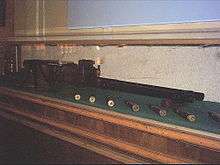Gryazev-Shipunov GSh-23
| GSh-23 | |
|---|---|
|
GSh-23L | |
| Type | Automatic cannon |
| Place of origin | Soviet Union |
| Service history | |
| In service | 1965-present |
| Used by | See Users |
| Production history | |
| Designer | KBP Instrument Design Bureau |
| Designed | 1960s |
| Manufacturer | KBP Instrument Design Bureau |
| Variants | GSh-23L |
| Specifications | |
| Weight |
GSh-23: 49.2 kg (108 lb) GSh-23L: 50 kg (110 lb) |
| Length |
GSh-23: 1,387 mm (4 ft 7 in) GSh-23L: 1,537 mm (5 ft 1 in) |
| Barrel length | 1,000 mm (3 ft 3 in) |
|
| |
| Cartridge | 23x115 mm AM-23 |
| Barrels | 2 |
| Action | Gast principle |
| Rate of fire | 3,400-3,600 rounds/min{http://ofbindia.gov.in/products/data/weapons/wmc/3.htm} |
| Muzzle velocity | 715 m/s (2,350 ft/s) |
The Gryazev-Shipunov GSh-23 (Russian: ГШ-23) is a twin-barreled 23 mm autocannon developed in the Soviet Union, primarily for military aircraft use. It entered service in 1965, replacing the earlier Nudelman-Rikhter NR-23 cannon.

The GSh-23 works on the Gast Gun principle developed by German engineer Karl Gast of the Vorwerk company in 1916. It is a twin-barreled weapon in which the firing action of one barrel operates the mechanism of the other. It provides a much faster rate of fire for lower mechanical wear than a single-barrel weapon.
Although it cannot match the sustained rate of fire of an electric Gatling gun like the M61 Vulcan GAU, because it doesn't need to spool up, its initial rate of fire is higher. It requires no external power source to operate, but is instead powered by the recoiling of the floating barrels, somewhat like the action of the German MG-42. The Gast principle has been little used in the West, but was popular in the former Soviet Union on a variety of weapons. It is reported to be a very reliable, robust weapon easily maintained in the field.
The cannon comes in a basic GSh-23 variant, and the more popular GSh-23L (ГШ-23Л), differing mostly in adding a muzzle brake, lowering recoil force. This cannon was standard fit on late-model MiG-21 fighters (M, SM, MF, SMT, bis), all variants of the MiG-23, the SOKO J-22 Orao, the HAL Tejas and IAR 93, and the tail turrets of the Tupolev Tu-22M bomber and some late-model Tu-95s. In that application, it had the unusual ability to fire infrared flares and chaff rounds, allowing it to function as both a weapon and a dispenser of anti-missile countermeasures. It is also mounted on late small series Mi-24VP helicopters (in the NPPU-23 movable mounting) and Polish W-3WA Sokół helicopter in fixed mounting. The cannon was also used on cargo aircraft; specifically, Russian/Soviet Ilyushin Il-76 aircraft were designed to accommodate twin Gsh-23L's in a tail turret.[1] An Il-76M with just such a configuration could be seen at the 2002 Ivanovo airshow.[2]
Some 2nd generation MiG-21 models could carry the GSh-23L in an under-fuselage gondola designated the GP-9, carrying the cannon and 200 rounds of ammunition; this was replaced by a more streamlined semi-conformal installation in later variants. There are also several gun pods available for mounting on external hardpoints: UPK-23 for air-to-air use, with one or two fixed GSh-23 guns and 200-400 rounds of ammunition, and SPPU-22 pods with traversable barrels for strafing, from 0° to −30° and carried 280 rounds of ammunition in each (they were most often carried by the Su-17/-20/-22 as well as the Su-25/-39 in pairs).
Users
 Brazil - Used on Mi-35M
Brazil - Used on Mi-35M Bulgaria
Bulgaria Bangladesh YAK-130,Mi-17,Mi-171Sh, JL-08W
Bangladesh YAK-130,Mi-17,Mi-171Sh, JL-08W  China
China Croatia
Croatia India Manufactured at Ordnance Factories Board[3]
India Manufactured at Ordnance Factories Board[3] Iraq on Iraqi aircraft type su-25
Iraq on Iraqi aircraft type su-25 Pakistan
Pakistan Poland
Poland Romania - manufactured locally by SC Uzina Mecanică Cugir as GȘ-23.[4]
Romania - manufactured locally by SC Uzina Mecanică Cugir as GȘ-23.[4]  Russia
Russia Serbia
Serbia Soviet Union
Soviet Union Vietnam
Vietnam Ukraine on SU-25M1[5]
Ukraine on SU-25M1[5] Tunisia - Used on L-59T Super-Albatross
Tunisia - Used on L-59T Super-Albatross Egypt - Used on L-59T Super-Albatross
Egypt - Used on L-59T Super-Albatross
See also
References
- ↑ "OKB-144 OKB-004 1/144 Ilyushin Il-76TD Soviet four-engined heavy commercial and military freighter. Model kits, Military and Technical Books and Magazines on www.Aviapress.com.". Retrieved 26 November 2014.
- ↑ "WWW.FOXBAT.RU ==". Retrieved 26 November 2014.
- ↑ "OFT develops Gen-X weapons". www.oneindia.com. Retrieved 26 November 2014.
- ↑ "cal. 23mm AIRCRAFT GUN GSh 23 TYPE". umcugir.ro. Retrieved 19 May 2012.
- ↑ "Su-25 M1 Frogfoot". redstar.gr.
- Koll, Christian (2009). Soviet Cannon - A Comprehensive Study of Soviet Arms and Ammunition in Calibres 12.7mm to 57mm. Austria: Koll. p. 155. ISBN 978-3-200-01445-9.
